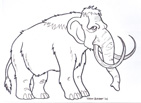Link between stress and a mammoth
When you think of stress, is a mammoth the first thing that comes to mind? Probably not. Yet, if we consider evolution and the role our stress response system played in ensuring our survival as a species, then our choice of logo becomes clearer. What do you think it would take to bring down a 4-6 ton mammoth? Some obvious choices are: strength, energy, speed, endurance, focus, fearlessness, and some good planning!
Would it surprise you to know that our stress response system is behind most if not all of these requirements? The stress response is also known as the fight or flight response because when we are faced with stress or a threat, we can fight (bring down the mammoth) or flee (run away because the mammoth is too aggressive). So, what happens when we have a stress response?

Our senses sharpen such that our pupils dilate (become larger) so we can see more clearly, even in darkness, our hairs stand on end, making us more sensitive to our environment and also making us appear larger as to intimidate our opponent, remember we were much harrier back then!
The cardio-vascular system leaps into action, our heart rate increases so we can pump more blood to our muscles, our arteries constrict to increase blood pressure and our veins open up to ease the return of blood to the heart.
The respiratory system joins in as the lungs, throat and nostrils open up and breathing speeds up to get more air in the system.
The blood carries oxygen to the muscles, allowing them to work harder and longer. We also breathe more deeply, which helps us to scream more loudly and sound threatening, the human equivalent of a roar!
Stored fat from fatty cells and glucose from the liver are sent into the blood or metabolized to create instant energy. Blood vessels to the kidney and digestive system are constricted to shut down systems that are not essential. This is not a time to waste energy!
Blood vessels to the skin are constricted reducing potential blood loss in the case of injury. Sweat glands also open, providing an external cooling liquid to our over-worked system (this makes the skin look pale and clammy). Endorphins, which are the body’s natural pain killers, are released because you don’t want to be bothered with pain while you are fighting. Our judgment system in the brain is also turned down so that more primitive responses take over, deep thought during this time could result in death–this is a time for action!
Lost in a Time-Warp
You may think that all of these biological events occurred only in prehistoric time, when we were chasing mammoths. Wrong. Your body basically does not know the difference between a mammoth and work-stress, so that in both situations, you have the same reactions. Basically, your body does not know that we are in 2011. Hence the choice of a mammoth as our logo to remind us of this important fact.
Was going on a mammoth hunt stressful? Absolutely! In fact, a situation like this is known as an absolute stressor. This means that absolutely anyone exposed to it would have a stress response. Other examples of absolute stressors are an earthquake, a tsunami, or the events of September 11th 2001. These are objective stressors that are universal.





